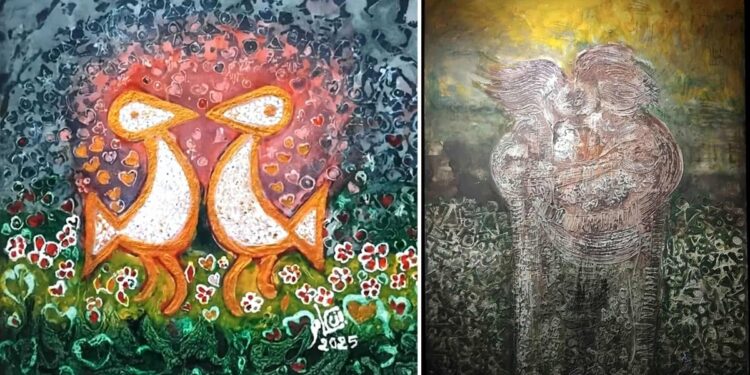Tribune | By Dr. Chaima Zaafouri, master assistant at the Higher Institute of the Arts and Crafts of Sidi Bouzid. Associated member of the LLTA, AX AX, Faculty of Letters and Human Sciences of Sfax.
By all his flesh, the paintings of artist Sami Ben Ameur vibrate with visceral energy; The funds, filled with air and light, breathe in the pictorial forms a vigor fueled by the desire for a healthy humanity. On his canvas, Ben Ameur models the material with the density of a sculptor, giving each deaf, fossilized color, testimony to an old and buried memory on each relief.
By closing your eyes, you can guess light masses, carried by a subtle gravity. The painter’s thought is freely deployed in this matter, without ever constraining the painting to a unique meaning. His reflection, rooted in the soil of war and peace, nevertheless marvels from the beauty of the world: he paints kiss, the tree, torture, a couple of birds, but especially the strata of the earth in resonance with the human in its most intimate and disturbing nature. His prompt hand cisèle rhymes and intuitions, translating by gesture the shows of war, the darkness saturated with light and shadow, the battlefields and the nightmares, with an intensity which makes the strange relief of the lens and emaciated skulls.
The artist creates and thus cultivates lands of mind and truth, aspiring to a free and sensual life. It is within this dimension crossed of ambivalence that Ben Ameur’s work imposes itself as an archeology of the sensitive, a feverish painting where the flesh, matter and color clash in a continuous, visceral, almost theological movement.
Painting, for him, is translating the incessant metamorphoses of the world, his decadents and rebirths, in a pictorial language where the invisible becomes a spiritual object of study and creation. Like materialist artists, it erects matter as a witness to the human condition.
Its universe extends to the edge of the carnal and the intangible, a space where the pulsations of a society are embodied whose artist deplores the loss of value. The line is softening, the color shudders, and the surface piles of a pictorial erethism, this overflow of sensitivity which transforms the painting in total sensory experience.
The interior tension is outcracted at the depths of the material, unfolds in the gestures and is consumed in the colors: a thrill of the world which infiltrates the frame of the painting. The elements are no longer hierarchical in a central order, but are deployed in a network, in moving interconnection, like the living world that Ben Ameur translates.
The landscape is built and deconstructs along a rational diagonal, without this structure leading the fluidity of flows or the circulation of affects and intensities. Guided by a feverish and excessive temperament, the painter lets out a dense emotion in matter and color, built of sorrow, bitterness and sometimes desperation, which crosses pictorial layers as a telluric current.
It is precisely this intimate and visceral experience of matter, its flesh, its memory, its buried strata, which gives the work its rhizomic power. Like the reflection proposed by Deleuze and Guattari, the work cannot be reduced to a single starting point or an imposed hierarchy: it unfolds as a rhizome, a complex network of strength lines where each element, whether strata, skulls, roots or emaciated flesh, simultaneously retains its autonomy and its insertion overall.
This configuration translates, through the singular experience of the artist, a world in perpetual circulation, in constant transformation, where matter and memory dialogue to reveal the interior and collective flows of existence.
The work becomes an indisposable totality, crossed by almost untenable contradictions, like contemporary fractures; Body, souls and territories. The painter works on the threshold of colorful synesthesia, where the viewer’s gaze perceives the vibration of tone as an emotion, where erethism of gesture translates the nervousness of contact and the palpitation of the flesh. Art becomes an area of interference between the sensitive and the conceptual, the spiritual and the body.
Ben Ameur claims a particular sensitivity, an aesthetic of memory exploring the loss and fragility of the time. Funders of the soul and the cracks in the world are transformed into visible traces and chromatic vibrations. The skulls suspended, the roots entwined and the white hearts, as many fossils of the collective memory, testify to the tension between life and disappearance, sensuality and pain.
Painting is not limited to aesthetics, it becomes resistance, exploration and meditation on human and universe, recalling that we are made of earth and fire, and that our bodies and our emotions remain malleable and capable of shouting in the abyss of existence.
Thus, the aesthetic feeling in his work becomes a field of resistance: the vitality of the gesture dialogue with the density and the transparency of his spiritual land. His work, excessive and feverish, testifies to a world in perpetual transformation, a world of which he returns injuries and beauties with incandescent intensity.
As Zola recalled at the Salon of 1866: “A work of art is a corner of creation seen through a temperament.” That of Ben Ameur is incandescent, carried by a floating gravity, a thrill of hungry bodies, a violent gaiety, a humanity full of cries and desires.
The virtuosity of his technique is based on the accumulation and superposition of diapers. The painting is deployed in visceral masses, sometimes stocky, sometimes aerial, where gravity and lightness coexist. Each relief, each texture is worked with a rapid intuition, an erethism of the gesture, which makes the pulsations of thought and flesh visible.
The colors, sometimes deaf, sometimes flamboyant, vibrate in a colorful synesthesia, reflecting the emotional intensity and the psychic complexity of the contemporary world. Pictorial erethism and materials transforms the canvas into a living space, where the eye feels the density and palpability of textures. The latter are worked with radical freedom: thick strata overlap, cracks and cracks create cracks of the soul, while strange reliefs; Skulls, roots, white hearts become memory fossils.
These elements, in their whole indisposable, establish a constant tension between the visible and the invisible, the sensual and the critic, the carnal and the theological. The artist does not seek clarity but the intensity, and this pre -eminence of matter makes each painting both spectacular and interrogative. His works reflect contemporary fractures; Body, territories, souls, they offer a space where painting becomes resistance to disembodied abstractions.
In his canvases vibrate unwavering links between individual memory and collective memory, erethism of colors, materials and gesture expresses the vicissitudes of the world and the incessant transformations of society. Ben Ameur’s movement and gesture are essential to his invoice. He paints as he thinks: by impulses, by bursts, by fast and precise gestures which sculpt pictorial matter. Each brush stroke, each overlap immerses energy, severity and a unifying gesture of meaning.
The color becomes vibration, palpitation, translation of the inner world, while matter, dense and tactile, imposes on the spectator a total sensory immersion. This colorful and material synesthesia makes the work feel beyond vision, in an almost bodily experience, where flesh, color and gesture intertwine.
The composition of its paintings, organized according to diagonals, masses and lines of force, remains guided by intuition and sensitivity. The elements collide, complement each other and respond according to an internal logic, generating vibrations and an erethism which make each painting a pictorial space conducive to critical reflection. The spectator is invited to penetrate this uncompromising totality, to feel the density of the field flesh, the tension of plasticity and the pulses of the contemporary world.
Thus, Ben Ameur’s work reveals, with a singular and rare intensity, the forces and cracks of our time. Flesh, memory and critical sensitivity mingle there, get away from it, weaving a pictorial language capable of whispering in the ear of the soul, from brushing it down, upsetting it, and instilling a new glow.
Immersed in his paintings, we let ourselves be engaged, cross by an inner light that burns and consoles at the same time, offering an intimate communion with the world: with others, with oneself, and awakening the consciousness of the fragility and the beauty of the existence that we have forgotten.








